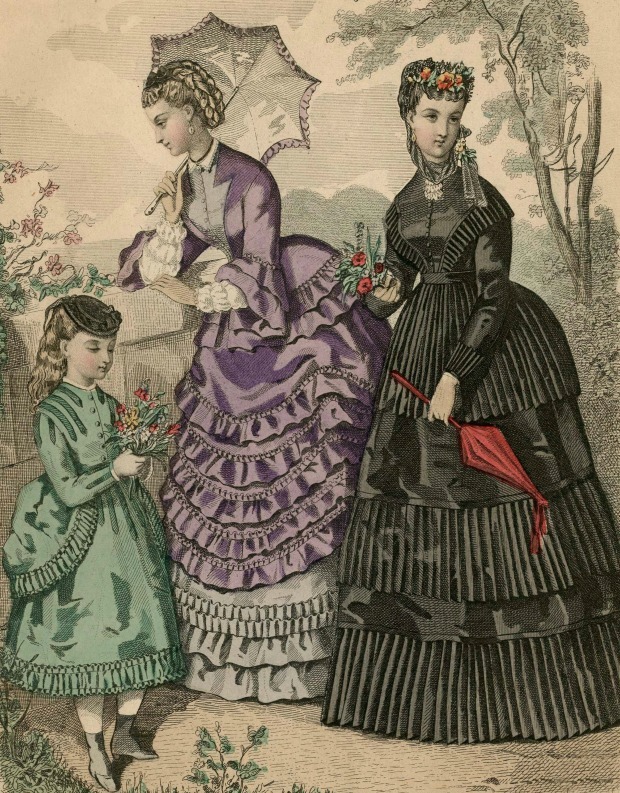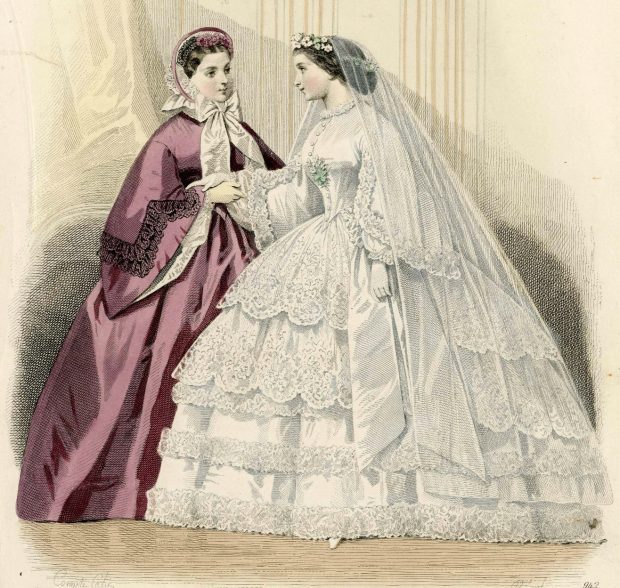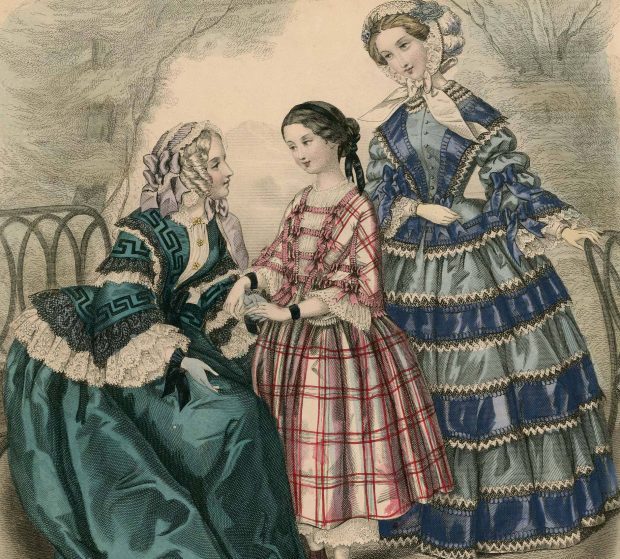In the Victorian era, women’s clothing was just as likely to spot, stain, and soil as it is today. For fine fabrics, this posed a particular dilemma. Ladies couldn’t simply throw their printed muslin dresses into a washing machine or send their silk ball gowns to the dry cleaners. Instead, they relied on their lady’s maids to keep their clothing clean and in good order. Not only would a competent lady’s maid know how to sponge and press a gown for wear, she would also know precisely how to wash a delicate muslin or remove an oil stain from silk.
Washing Printed Muslin
 Journal Des Jeunes Personnes, 1863. (Met Museum)
Journal Des Jeunes Personnes, 1863. (Met Museum)
Dresses of printed muslin were very popular during the nineteenth century. These dresses could be washed, but if the fabric was patterned or printed, great care had to be taken to preserve the colors. For this reason, it was inadvisable for a muslin dress to be washed in hot water. Soap, when applied directly to the fabric, was equally harmful. Instead, the 1856 edition of Godey’s Lady’s Book recommends that a lady’s maid:
“Make a lather by boiling some soap and water together; let it stand until it is sufficiently cool for use, and previously to putting the dress into it, throw in a handful of salt.”
After soaking, the muslin dress would go through a double rinse in “clear cold water” and salt. The dress was then carefully wrung out and hung to dry with the folds spread “as open as possible” so that no part of the dress was lying over another part.
Removing Ordinary Stains From Silk
 Les Modes Parisiennes, 1858. (Met Museum)
Les Modes Parisiennes, 1858. (Met Museum)
The process of cleaning silk dresses was a bit more complicated than simply washing the fabric in soap and water. To remove ordinary stains, a lady’s maid generally employed some variety of spot solution. The 1861 edition of Godey’s Lady’s Book describes one such solution comprised of:
“Quarter of a pound of honey; quarter of a pound of soft soap; two wineglasses of gin; three gills of boiling water.”
These ingredients were mixed well and left to stand until the solution was “blood-warm.” It could then be applied to the silk with a small brush, with special attention to stains or spots of dirt. A lady’s maid would next use a sponge to “wet the whole breadth of fabric” and to rub gently over the soiled areas. With the cleaning completed, the silk dress could be rinsed in “cold soft water” and hung up to drain. As for drying, the 1861 edition of Beeton’s Book of Household Management states that:
“Silks, when washed, should be dried in the shade, on a linen-horse, taking care that they are kept smooth and unwrinkled.”
As a final step, a lady’s maid would iron the dress while it was still damp. However, if the dress was black or dark blue, Beeton’s advises that, once dry, the dress should be spread out over a table and “sponged with gin, or whiskey, or other white spirit.”
Removing Oil Stains From Silk, Satin, And Velvet
 Allgemeine Modenzeitung, 1861. (Met Museum)
Allgemeine Modenzeitung, 1861. (Met Museum)
Stubborn stains, such as those from oil, could be treated with a number of substances, depending on preference. These substances included turpentine, benzene, gasoline, magnesia, French chalk, chloroform, pipe clay, and even the yolk of an egg or the juice of a raw potato. The 1909 edition of Household Discoveries advises that a lady’s maid:
“Lay the stained article flat on a smooth surface and apply the cleansing fluid with a small sponge, toothbrush, or nailbrush, unless otherwise directed, until the stain is removed.”
When using gasoline or benzene, the cleaning solution was applied not only to the spot, but also to “a rather large circle around it.” A lady’s maid would then “rub outward from the center with quick, firm strokes.” If the benzene left a stain, it could be held under the steam of a teakettle until the stain disappeared.
Grease spots could also be rubbed out with “a lump of wet magnesia.” When dry, the magnesia could be dusted off the fabric. Another alternative, was to cover a grease spot with a liberal application of French chalk. Brown paper was then placed over the chalk and smoothed with a hot iron. According to Household Discoveries, “the iron will melt the grease and the chalk and paper will absorb it.”
In a slight variation of the above, the 1869 edition of Godey’s recommends that French chalk and lavender water be mixed together to form a thick paste. The paste was applied to the stain and rubbed gently into the fabric with the fingers. It was then covered with “a sheet of clean blotting-paper and brown paper over it” and smoothed with an iron. When dry, the remaining chalk could be dusted off with “a white handkerchief.”
Pipe clay was another method for removing oil stains from fine fabric. The powdered clay was moistened with water until it formed a thick cream. The 1863 edition of Godey’s Lady’s Book reports that it was then:
“…laid on the stain, and left to dry some hours, then lightly scraped or rubbed off with a knife or flannel, so as not to injure the surface.”
If the pipe clay dried to a light color, it meant that the oil stain had been removed. Pipe clay was safe to use on most fabrics and, according to Godey’s, “will not injure the most delicate tints of silk or paper.”
Removing Stains from Mourning Dresses of Crape and Bombazine
 Magasin des Demoiselles, 1869. (Met Museum)
Magasin des Demoiselles, 1869. (Met Museum)
When cleaning dark fabrics, like the black crapes and bombazines used for mourning dresses, a lady’s maid often employed a solution made of fig leaves. The 1869 edition of Godey’s reports that this solution could be obtained by boiling “a handful of fig leaves in two quarters of water until reduced to a pint.” This solution was then applied to the fabric with a sponge.
Washing Lace Collars, Cuffs, And Trim
 Les Modes Parisiennes, 1861. (Met Museum)
Les Modes Parisiennes, 1861. (Met Museum)
On a Victorian lady’s gown, the collar and cuffs were generally soiled long before the rest of the dress. When made of cotton or muslin, it was easy enough to remove them and have them laundered. However, when collar and cuffs were made of lace, the process for washing them was a bit more difficult. For this reason, the 1861 edition of Godey’s Lady’s Book advises that every lady “should know how to wash her own thread lace.”
The first step was to remove the lace from the gown. According to Godey’s, a lady must then “roll the lace very smoothly and securely round a clean black bottle” and “tack each end of the lace with a needle and thread to keep it smooth.” Once the lace was on the bottle, it was thoroughly sponged with “sweet oil” and then soaked in a wash kettle containing “clear water and white Castile soap.”
Godey’s recommended that a lady leave the lace to boil in the sudsy water for “an hour or more” until the lace was “clean and white all through” The suds were then drained off and the lace was left to dry in the sun. Once dry, the lace—depending on its size—could be wrapped around a ribbon-block or placed between two sheets of white paper and pressed flat in a large book.
A few final words…
 Musee Des Famille, 1852. (Met Museum)
Musee Des Famille, 1852. (Met Museum)
There was no single way to spot clean a Victorian gown. Many lady’s maids had their own special mixtures, perhaps some secret combination of turpentine, benzene, or chalk. Caring for the fine fabrics of their mistress’s gowns was as much a part of their job as knowing the latest hairstyles in which to style their mistress’s hair. I hope this article has given you some little insight into how they did it.
Top photo via Victoria/ITV
This post originally appeared on MimiMatthews.com and is reprinted here with permission.
Originally published on BUST.com December 6, 2017; originally published on MimiMatthews.com November 26, 2017
More from BUST
Alexandra Of Denmark Had SO MANY DOGS
Here’s What Victorian Women Used For HairsprayHere’s What Victorian Women Used For Hairspray


